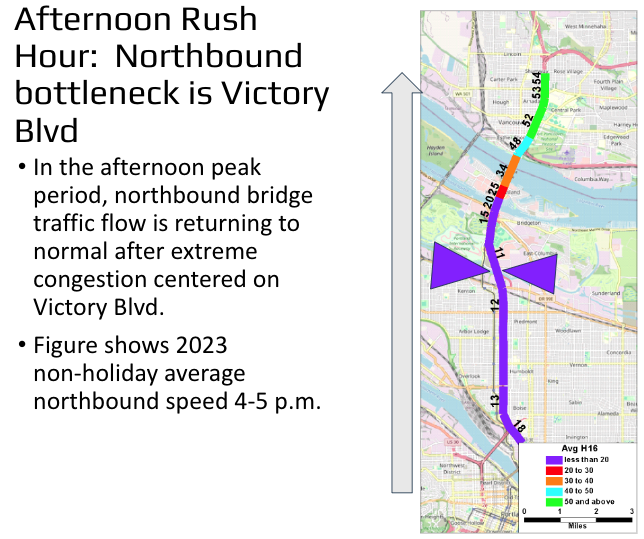IBR and Metro effectively admit critics are right about problems with their traffic modeling
The real traffic problems on I-5 are outside the IBR project area, and won’t be solved by the $7.5 billion project
The documented errors in traffic modeling undercut the case for this megaproject, and show it would make traffic and pollution worse and would be a tragic waste of resources.
In October, the Just Crossing Alliance released a scathing report from national traffic expert Norm Marshall, finding that the traffic modeling for the proposed $7.5 billion Interstate Bridge project is badly flawed, and that the project will do nothing to relieve chronic congestion in I-5, because the critical bottleneck lies outside the project area. As Marshall said succinctly:
“The congestion is caused by bottlenecks to the south—at North Lombard in the southbound a.m. peak and at Victory Boulevard in the p.m. northbound peak, and there is no possibility that widening the bridge can address those problems.”
Willamette Week challenged Metro and IBR officials to respond to the critique, and their responses are the classic word-salad of a non-denial denial. Here’s IBR’s Greg Johnson
“The Interstate Bridge replacement program is a 5-mile segment in a regional transportation network,” Johnson says. “While IBR investments will reduce congestion and improve safety at the I-5 Interstate Bridge, we cannot solve the region’s congestion problems, such as bottlenecks outside of the program area, but we can do our part to make it more efficient. Design improvements, multimodal investments, including extension of light rail and express bus enhancements, safety shoulders throughout the IBR Program area, variable rate tolling, and the addition of an auxiliary lane across the bridge to enhance ramp-to-ramp connections will help improve the flow of traffic both on the bridge and throughout the IBR 5-mile program corridor.”
When you break that down, Johnson doesn’t dispute Marshall’s analysis, and concedes that the project may only reduce congestion “at the I-5 bridge” and “on the bridge” and in the projects “program corridor.” The trouble is that the actual bottlenecks that cause congestion around the bridge aren’t actually on the bridge and are located outside the “program corridor.” As a result, we’ll spent $7.5 billion on a massive freeway widening, and traffic will not be better, but will actually be worse.
Marshall’s key insight was that while traffic backs up on and near the I-5 bridge, the real problem is limited capacity on I-5 south of the project area, with peak southbound traffic backing up from N. Lombard, and peak northbound traffic backing up from Victory Boulevard.
Marshall’s analysis concludes that the I-5 bridge widening won’t do anything to alleviate these real bottlenecks, and that the IBR will actually make congestion worse by funneling more traffic into the bottlenecks.
A flawed model using an outdated, inaccurate methodology
Similarly, Metro officials offered up a similar non-denial of Marshall’s critique of the Metro modeling used to make the IBR’s traffic forecasts.
“The model results we provided to IBR are from a model that looks at travel patterns at a regional level—it estimates the number of daily trips across the Columbia River on both bridges. The ‘dynamic’ model Mr. Marshall cites is a supplement to, not a component of, regional models like Metro’s. IBR did not ask Metro for any data beyond the output from the regional ‘static’ model we provided,”
“We think our model performs well when estimating transportation choices at a regional level—the basis for a lot of decisions on large projects, like the proposal to replace our 107-year-old drawbridge over the Columbia River.”
As the Marshall report shows, the “static” model used in the Metro (and IBR) modeling fails to accurately account for capacity limitations on the I-5 bridge, and reflect the interaction between congestion on one part of the freeway system on upstream and downstream segments. As a result, it over-predicts traffic for the “No-build” scenario, and presents an inaccurate picture of the environmental effects of widening the freeway. And the dynamic modeling isn’t somehow a “supplement” for the out-dated static modeling used by Metro, but a superior replacement technique that more accurately predicts traffic levels. And contrary to the claims that the Metro model “performs well,” Metro’s own model validation report–which it doesn’t publish on the agency’s website–shows that the Metro model consistently over-estimates traffic on the I-5 bridge by nearly 20 percent in the current year.
“Industry standard” where the standard in the industry is to exaggerate
Johnson defends the.IBR modeling efforts as using “industry best practices”–but in this case, that’s both misleading and untrue. It is common industry practice to exaggerate traffic forecasts. Likewise, according to Johnson, it is “industry standard” practice to ignore the decline in commuting because of increased work-from-home in the aftermath the Covid pandemic. But the real world best practice–required by financial markets in analyzing funding proposals for highway projects–is something called an “investment grade analysis.” IBR’s own documents concede that investment grade studies are more rigorous, detailed and accurate than the estimates contained in the EIS. And strikingly, investment grade analyses produce much lower levels of future traffic than models used by highway agencies like IBR.
As Ben Ross and I demonstrated in our article at Dissent Magazine, the standard practice of state highway departments (and their consultants) is to produce inaccurate traffic projections that falsely exaggerate predicted future traffic growth to rationalize over-sized highway projects. As we’ve documented at CityObservatory, the IBR’s traffic projections are replete with error.
Traffic projections are central to the case for the $7.5 billion project: they define the need for the project, justify its size (and expense), and are used to understand its environmental impacts–and to calculate how much revenue tolling will provide. Because the traffic modeling is wrong, everything that IBR is claiming about the bridge is wrong as well: it won’t fix congestion, it is vastly over-sized relative to demand, it will cause massive diversion to I-205, and it will fail to generate expected toll revenues.

